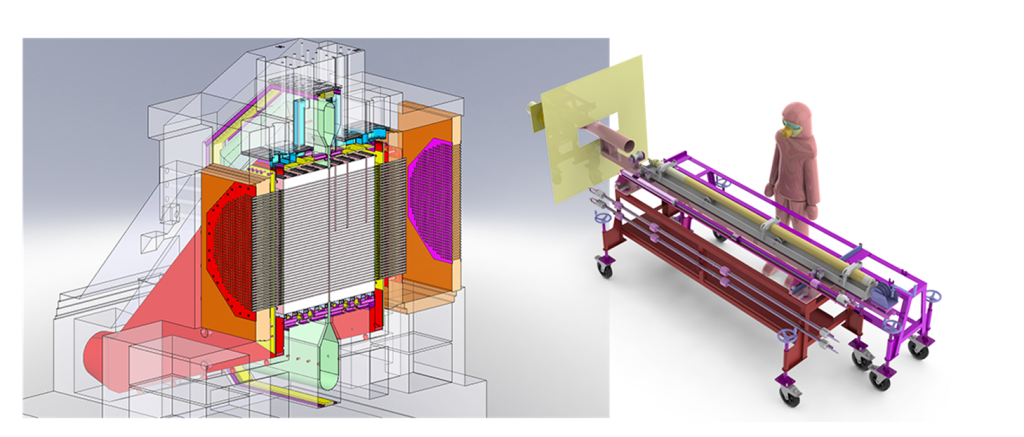- The Group
- Countries Websites
Decommissioning the CEA’s G1 reactor in Marcoule: Onet Technologies to resume investigations and sampling with Eiffage Génie Civil.

What is the G1 project? Who is the customer?
The G1 reactor is the first nuclear reactor built in France for military applications. The Atomic Energy Commission (CEA) began its construction in 1955 in Marcoule and it became operational just a year later. It is also the first reactor to produce electricity from a nuclear reaction. It is a GCR-type reactor (Gas-Cooled Reactor, moderated with graphite, also abbreviated as “UNGG”) made of 1200 tons of graphite, from which it gets its name (the G stands for “graphite”). Operations stopped in 1968 and the reactor has been waiting for nuclear decommission since then.
The G1 sampling and core drilling project chiefly consists in carrying out investigations and obtaining samples. The goal is to better understand the physical and radiological condition of the reactor in order to establish decommissioning scenarios and identify the various waste management options (including for graphite).
These tasks were entrusted by the CEA to a partnership between Onet Technologies and Eiffage Génie Civil in 2010. After a first round of on-site investigations and topographical surveys, decommissioning scenarios were used to create tailored equipment. This equipment was in turn tested on a mock-up in 2013. After a first sampling phase in 2016, unexpectedly high-levels of tritium emissions forced the CEA to suspend operations and add a venting system for the tritium. Operations resumed in January 2021 after renegotiation of the purchase order.
How is Onet Technologies involved?
Onet Technologies is managing the project with Eiffage Génie Civil. Both companies bring their own expertise to the project.
Eiffage EGCN handles the core drilling operations for concrete structures (similar operations were carried out on EDF’s GCR-type reactors in 2008-2009, already in partnership with Onet Technologies) and in the reactor’s graphite elements. The challenges here being trajectory control (reaching specific areas and avoiding singularities in the reactor) and keeping the graphite at temperatures below 60 °C.
Onet Technologies handles every other type of sampling (investigations and small-diameter core drilling in fuel channels, reactor equipment and instrumentation sampling, graphite containment steel belt sampling) as well as site management, ventilation connection and fine tuning, and radiation protection.
What are the fields of technical expertise involved?
Ever since the project began, most of Onet Technologies’ many fields of technical expertise have been involved at one point or the other: radiation protection engineering, safety, mechanical engineering, general installation, waste reduction and management, and ventilation. When the project resumed, the mechanical department had to modify pieces of equipment, carry out preventive maintenance operations, and train the new operators to using the tools while the ventilation department had to assemble, fine tune and test the equipment.
What are the project’s main phases?
There are several major phases: firstly, on-site installation phases with air locks and ventilation will precede each on-site sampling phase. The first on-site sampling phase will last for 6 months and cover investigation and sampling of the fuel channels and airtight plugs. Work will be carried out in a testing hall which lacks local ventilation capabilities: work will be carried out after lowering the pressure of the reactor and installing ventilated containment barriers.
The next phase will be the extraction and sampling of the control rods, which will last for about 4 months depending on the additional extra operations the CEA may require and will be followed by Eiffage Génie Civil’s core drilling operations. Finally, the last sampling phase is scheduled for the second half of 2022 and will consist in sampling the steel elements found in the lower half of the reactor (which are very difficult to access).
The core drilling phase requires a high level of accuracy: it needs to be around 10-13 cm in depth after drilling through 7 m of reinforced concrete, 1-1.5 m of air and 5 m of graphite, sometimes at an angle. Mock-up testing back in 2013 provided very useful insights into such configurations but the exact specifications of the reactor (concrete quality, layout of the internal structures) is still uncertain. Repeated displacement measurements paired with TV inspections and comparison with topographical data will allow for trajectory correction or core drilling repositioning.
When it comes to graphite samples, the CEA wishes to check whether residual Wigner energy remains in the graphite. Such energy can be liberated at temperatures close to 100 °C and therefore may constitute a fire hazard. A large quantity of samples will be handed over to the CEA, who will then carry nuclear measurement analyses on site or in a laboratory in order to establish the chemical composition and activity of the samples.
Onet Technologies and Eiffage Génie Civil will continue operations in a timely manner while ensuring the highest level of security.
- Onet Technologies Japan
A question or a project ?
Our Onet Technologies experts are at your disposal to answer all your requests for information.
